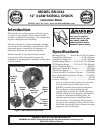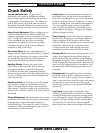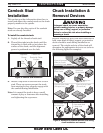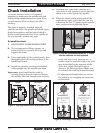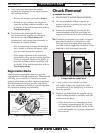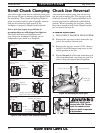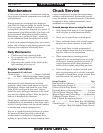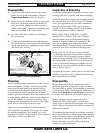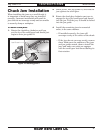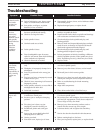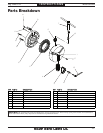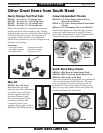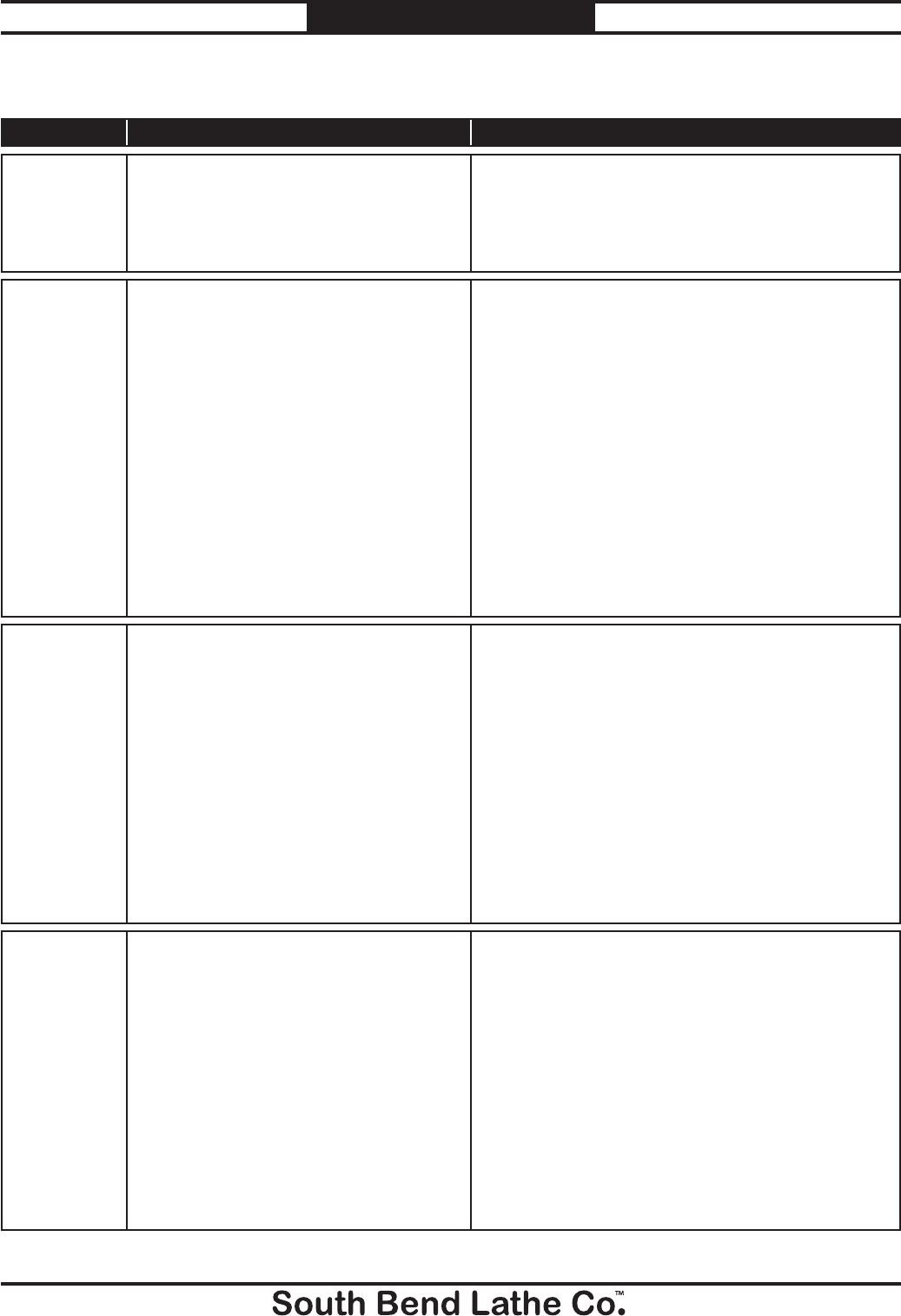
Symptom Possible Cause Possible Solution
Chuck mounts
or seats
incorrectly;
gap exists
between chuck
and spindle;
chuck vibrates
during
operation
without a
workpiece
installed.
1.
Chuck is loose or cocked on spindle; gap
between spindle/chuck mating.
1.
Remove chuck then clean and dress all mating
surfaces of spindle & chuck.
2.
Chuck is too large for lathe.
2.
Install smaller lathe chuck so spindle and bearings
will not become overloaded and vibrate.
3.
Lathe spindle is loose.
3.
Check and adjust lathe spindle end-play and
bearing preload.
4.
Camlock studs are at fault.
4.
Remove chuck and inspect/adjust/replace camlock
studs for wear or damage as required. Re-install
chuck with registration marks aligned.
5.
Lathe spindle is loose.
5.
Check and adjust lathe spindle end-play and
bearing preload. Adjust as required.
6.
Poor chuck/spindle taper fit causes
radial or axil runout from chuck shifting
when camlocks are tightened.
6.
Isolate component at fault by installing a different
chuck. If problem persists, lathe spindle may be at
fault. If problem goes away, chuck may be at fault.
7.
Chuck is distorted or cracked.
7.
Replace chuck.
The chuck key
is hard to turn,
or it binds
at some jaw
locations.
1.
Jaws poorly positioned.
1.
Re-install jaws in correct order and position.
2.
Lack of lubrication; rust, burrs, metal
chips, or contaminants inside chuck.
2.
Disassemble, de-burr, clean, and re-lubricate chuck
with chuck grease.
3.
Jaw guides, scroll gear, or pinion
distorted, worn, or broken.
3.
Replace damaged parts, or replace chuck.
The workpiece
slips in the
jaws.
1.
Workpiece requires additional support
in addition to chuck jaws.
1.
Use tailstock, rests, and outboard spindle support.
Use slower spindle speed.
2.
Incorrect jaw or workpiece clamping
position.
2.
Re-position jaws and workpiece for maximum scroll
gear and jaw engagement. Verify that workpiece is
not too large or heavy for chuck.
3.
Two-piece jaw is loose; top jaw
improperly seated in master jaw.
3.
Remove jaws, clean mounting surfaces, and re-
install with the correct cap screw torque.
4.
Insufficient pinion and scroll gear
torque.
4.
Lubricate chuck, and re-tighten the chuck key.
5.
Jaws or jaw screws bind before full
clamping force is achieved.
5.
Service the chuck as described in this document.
6.
Cutting overload.
6.
Reduce cutting depth or feed rate.
7.
Jaw teeth worn; 2-piece jaw is loose.
7.
Have jaws reground, replace jaws, or replace chuck.
Troubleshooting
Workpiece
has runout;
clamping
accuracy or
repeatability is
poor; turning
results are
poor.
1.
Workpiece is too long for jaw clamping
only.
1.
Use tailstock, rests, and outboard spindle support;
use slower spindle speeds.
2.
Workpiece is improperly clamped or is
misaligned.
2.
Remove jaws, then clean, de-burr, and re-install.
3.
Jaws are positioned in the wrong jaw
guides.
3.
Re-install jaws in their correct guides.
4.
Top jaws are loose or improperly seated
in their master jaws.
4.
Remove jaws, clean jaw teeth and guides, then re-
install jaws using the correct torque for fasteners.
5.
Chuck is loose; mounting is off center or
improperly seated.
5.
Refer to troubleshooting for chuck mounting
incorrectly.
6.
Lathe spindle, tailstock, or cross slide is
misaligned with lathe bed.
6.
Align lathe components.
7.
Lathe bed is twisted.
7.
Place shims under lathe to level bed ways.
-10-
Mfg. Since 1/11
Model SB1224
INSTRUCTIONS



